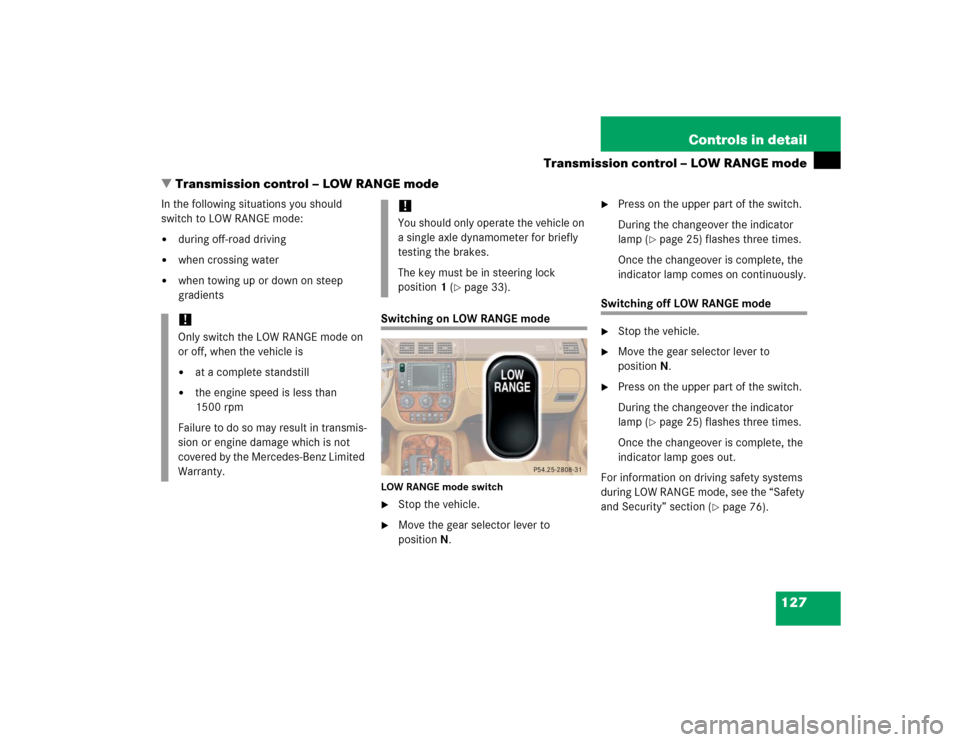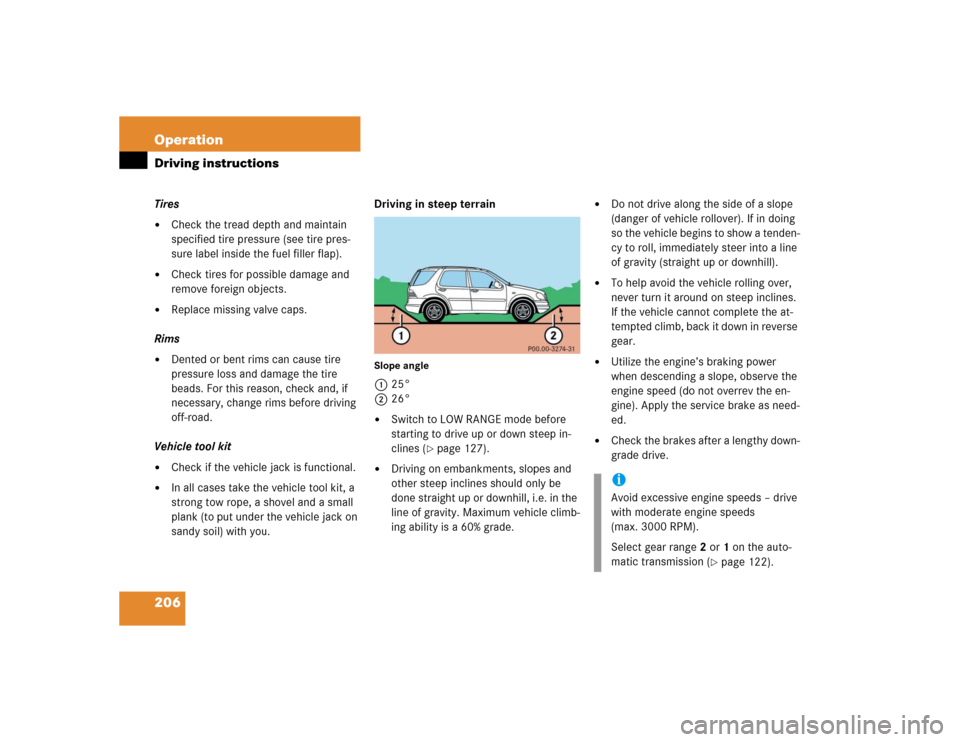Page 128 of 356
126 Controls in detailAutomatic transmissionEmergency operation (Limp Home Mode)
If vehicle acceleration worsens or the
transmission no longer shifts, the trans-
mission is most likely operating in limp
home (emergency operation) mode. In this
mode only second gear and reverse gear
can be activated.�
Stop the vehicle.
�
Move gear selector lever to positionP.
�
Turn off the engine.
�
Wait at least ten seconds before
restarting.
�
Restart the engine.
�
Move selector lever to positionD
(for second gear) orR.
�
Have the transmission checked at an
authorized Mercedes-Benz Light Truck
Center as soon as possible.
Page 129 of 356

127 Controls in detail
Transmission control – LOW RANGE mode
�Transmission control – LOW RANGE mode
In the following situations you should
switch to LOW RANGE mode:�
during off-road driving
�
when crossing water
�
when towing up or down on steep
gradients
Switching on LOW RANGE modeLOW RANGE mode switch�
Stop the vehicle.
�
Move the gear selector lever to
positionN.
�
Press on the upper part of the switch.
During the changeover the indicator
lamp (
�page 25) flashes three times.
Once the changeover is complete, the
indicator lamp comes on continuously.
Switching off LOW RANGE mode�
Stop the vehicle.
�
Move the gear selector lever to
positionN.
�
Press on the upper part of the switch.
During the changeover the indicator
lamp (
�page 25) flashes three times.
Once the changeover is complete, the
indicator lamp goes out.
For information on driving safety systems
during LOW RANGE mode, see the “Safety
and Security” section (
�page 76).
!Only switch the LOW RANGE mode on
or off, when the vehicle is�
at a complete standstill
�
the engine speed is less than
1500 rpm
Failure to do so may result in transmis-
sion or engine damage which is not
covered by the Mercedes-Benz Limited
Warranty.
!You should only operate the vehicle on
a single axle dynamometer for briefly
testing the brakes.
The key must be in steering lock
position1 (
�page 33).
Page 157 of 356

155 Controls in detail
Driving systems
Setting a higher speed�
Lift the cruise control lever to
position1 and hold it up until the de-
sired speed is reached.
�
Release the cruise control lever.
The new speed is set.
Setting a lower speed
�
Depress the cruise control lever to
position2 and hold it down until the
desired speed is reached.
�
Release the cruise control lever.
The new speed is set.Fine adjustment in 1 mph
(Canada: 1 km / h) increments
Faster
�
Briefly tip the cruise control lever in the
direction of arrow1.
Slower
�
Briefly tip the cruise control lever in the
direction of arrow2.Setting to last stored speed (“Resume”
function)
�
Briefly push the cruise control lever to
position4.
The cruise control will resume the last
set speed.
�
Remove your foot from the accelerator
pedal.
Transmission in LOW RANGE mode
iDepressing the accelerator pedal does
not deactivate the cruise control. After
brief acceleration (e.g. for passing),
cruise control will resume the last
speed set.
iWhen you use the cruise control lever
to decelerate, the transmission will au-
tomatically downshift if the engine’s
braking power does not brake the vehi-
cle sufficiently.
Warning!
G
The speed stored in memory should only be
set again if prevailing road conditions per-
mit. Possible acceleration or deceleration
differences arising from returning to preset
speed could cause an accident and / or seri-
ous injury to you and others.iThe cruise control should not be used
during off-road driving.
Page 189 of 356

187 Controls in detail
Useful features
Step 9:�
Press “training” button on the garage
door opener motor head unit.
The “training light” is activated.
You have 30 seconds to initiate the
following step.
Step 10:
�
Firmly press, hold for two seconds and
release the programmed integrated
signal transmitter button (3, 4
or5).
Step 11:
�
Press, hold for two seconds and
release same button a second time to
complete the training process.
Some garage door openers (or other rolling
code equipped devices) may require you to
perform this procedure a third time to
complete the training.Step 12:
�
Confirm the garage door operation by
pressing the programmed integrated
signal transmitter button (3, 4
or5).
Step 13:
�
To program the remaining two buttons,
repeat the steps above starting with
step 3.Gate operator / Canadian programming
Canadian radio-frequency laws require
transmitter signals to “time-out” (or quit)
after several seconds of transmission
which may not be long enough for the inte-
grated signal transmitter to pick up the sig-
nal during programming. Similar to this
Canadian law, some U.S. gate operators
are designed to “time-out” in the same
manner.
If you live in Canada or if you are having dif-
ficulties programming a gate operator (re-
gardless of where you live) by using the
programming procedures, replace step 4
with the following:
Page 206 of 356

204 OperationDriving instructionsStanding water
Off-road driving
Read this chapter carefully before you be-
gin off-road travel.
Familiarize yourself with the vehicle char-
acteristics and gear changing before you
attempt any difficult terrain off-road driv-
ing. We recommend that you start out with
easy off-road travel.
!Do not drive through flooded areas or
water of unknown depth. Before driving
through water, determine its depth.
Never accelerate before driving into
water. The bow wave could force water
into the engine and auxiliary equip-
ment, thus damaging them.
If you must drive through standing wa-
ter, drive slowly to prevent water from
entering the passenger compartment
or the engine compartment. Water in
these areas could cause damage to
electrical components or wiring of the
engine or transmission, or could result
in water being ingested by the engine
through the air intake, causing severe
internal engine damage. Any such dam-
age is not covered by the
Mercedes-Benz Limited Warranty.
Warning!
G
Drive slowly in unknown terrain. This will
make it easier to recognize unexpected ob-
stacles and avoid damage to the vehicle.
To help avoid the vehicle rolling over, never
turn it around on steep inclines. If the vehi-
cle cannot complete the attempted climb,
back it down in reverse gear.
Do not drive along the side of a slope (dan-
ger of vehicle rollover). The vehicle might
otherwise rollover. If in doing so the vehicle
begins to show a tendency to roll, immedi-
ately steer into a line of gravity (straight up
or downhill).
Never let the vehicle roll backwards in idle.
You may lose control of the vehicle if you
use only the service brake.
Warning!
G
Sand, dirt, mud and other material having
friction property can cause exceptional wear
and tear as well as brake failure.
Have the brakes checked for dirt build-up
and cleaned. There is otherwise a risk that
full braking power may not be available in an
emergency.
Page 208 of 356

206 OperationDriving instructionsTires�
Check the tread depth and maintain
specified tire pressure (see tire pres-
sure label inside the fuel filler flap).
�
Check tires for possible damage and
remove foreign objects.
�
Replace missing valve caps.
Rims
�
Dented or bent rims can cause tire
pressure loss and damage the tire
beads. For this reason, check and, if
necessary, change rims before driving
off-road.
Vehicle tool kit
�
Check if the vehicle jack is functional.
�
In all cases take the vehicle tool kit, a
strong tow rope, a shovel and a small
plank (to put under the vehicle jack on
sandy soil) with you.Driving in steep terrain
Slope angle1 25°
226°�
Switch to LOW RANGE mode before
starting to drive up or down steep in-
clines (
�page 127).
�
Driving on embankments, slopes and
other steep inclines should only be
done straight up or downhill, i.e. in the
line of gravity. Maximum vehicle climb-
ing ability is a 60% grade.
�
Do not drive along the side of a slope
(danger of vehicle rollover). If in doing
so the vehicle begins to show a tenden-
cy to roll, immediately steer into a line
of gravity (straight up or downhill).
�
To help avoid the vehicle rolling over,
never turn it around on steep inclines.
If the vehicle cannot complete the at-
tempted climb, back it down in reverse
gear.
�
Utilize the engine’s braking power
when descending a slope, observe the
engine speed (do not overrev the en-
gine). Apply the service brake as need-
ed.
�
Check the brakes after a lengthy down-
grade drive.iAvoid excessive engine speeds – drive
with moderate engine speeds
(max. 3000 RPM).
Select gear range2 or1 on the auto-
matic transmission (
�page 122).
Page 209 of 356

207 Operation
Driving instructions
Traction in steep terrain�
Be easy on the accelerator and watch
for continuous wheel traction when
driving in steep terrain.
The 4-ETS helps greatly when starting
out on a steep incline when the front
wheels have then the tendency to slip
due to the weight shifting away the
front axle.
The 4-ETS recognizes the situation and
limits the torque for the front wheels by
braking them. Simultaneously the
torque for the rear wheels is increased.Driving across a hilltop
�
Decelerate just ahead of a hilltop (do
not select gear rangeN), to prevent the
vehicle from speeding up too much af-
ter climbing a hill.
Use the momentum of the vehicle to
drive across the hilltop.
Driving in this manner prevents the ve-
hicle from jumping across the hilltop
and thus loosing its forward momen-
tum.Driving downhill
�
Select gear range1 on the automatic
transmission (
�page 122).
�
Drive downhill observing the same
rules as driving uphill (
�page 206).
�
The special LOW RANGE – ABS setting
allows for precise and brief (cyclical)
blocking of the front wheels, permitting
them to dig into loose ground.
Remember that the front wheels when
stopped, slide across a surface, thus
loose their ability to steer the vehicle.
Page 210 of 356

208 OperationDriving instructionsDriving through water
120 in (50 cm)�
Before driving through water, deter-
mine its depth.
It should not be deeper than approxi-
mately 20 inches (50 cm).
Make sure you check the water bed.
The ground surface may not be firm
which may result in deeper waters than
expected when driving the vehicle
through it.
�
Switch to LOW RANGE mode before
driving through water (
�page 127).
�
Switch off the exterior lamps as well as
the automatic climate control.
�
Select gear range1 on the automatic
transmission (
�page 122).
�
Enter the water only at a shallow spot,
driving at walking speed.
�
Do not stop vehicle while immersed in
water, and do not shut off the engine.
There is a very high level of driving re-
sistance in water. The surface is slip-
pery and may not be firm, making
pulling away in water difficult and dan-
gerous.
�
Clean mud off the tire tread after driv-
ing through water.
�
To dry the brakes, apply pressure to the
brake pedal several times after leaving
the water.
!Never accelerate before driving into
the water. The bow wave could force
water into the engine and auxiliary
equipment, thus damaging them.